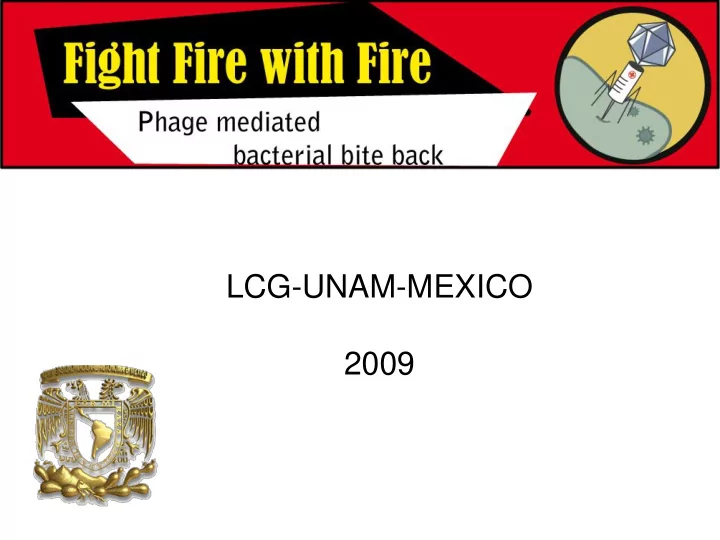

LCG-UNAM-MEXICO 2009
MOTIVATION • Industry processes involving microorganisms could be severely affected by viral infections. • Manipulate and model the infection process is an interesting challenge . • Constructing a transduction iGEM standard system, portable wide host range.
SOLUTION Engineer and standardize a bacteriophage so it delivers a synthetic defense construction, thus leaving bacteria of interest protected against other phages.
MAIN OBJECTIVES • Design and standardize a biobrick delivery system based on transduction. • Construct a population-scale phage defense system. • Develop a multiscale model to simulate phage infections and performance of our defense system.
Delivery / Defense 1) Delivery system 2) Defense system
Delivery system a) Production b) Delivery
Defense system a) DETECTION b) KAMIKAZE c) GOSSIP d) PARANOIA
Defense system DETECTION: A specific element of the phage (Bad guy) triggers a transcriptional response.
Defense system a) DETECTION b) KAMIKAZE c) GOSSIP d) PARANOIA
Defense system KAMIKAZE: Kills the cell as fast as possible to avoid the formation of new viral particles.
Defense system a) DETECTION b) KAMIKAZE c) GOSSIP d) PARANOIA
Defense system GOSSIP: Like an alarm, bacteria start spreading the rumor that a phage (bad guy) is near.
Defense system a) DETECTION b) KAMIKAZE c) GOSSIP d) PARANOIA
Defense system As an extention ….. PARANOIA: Anticipates a response against phages before the infection happens.
The complete system
Main Goal • Engineer a device which can transduce synthetic DNA constructions into different bacterial hosts.
Overview • Select, standardize viral plasmid • Control the production of phages • Transduce bacteria with viruses
It complements P4 reproduction!! It’s a non lytic phage
Nonessential region + integrase Bjorn H. Lind Qvist, Gianni Deho and Richard Calendar, Mechanisms of genome propagation and helper explotation by satellite phage P4. Microbiological Reviews, Sep. 1993, p. 683.702
P4 Production Goals.- Engineer a strain with P2 particle formation genes Control P4 particle formation with P2 regulators (control construction)
Control construction • IPTG inducible • Cox and ogr regulators (global for P2)
Mass production
Applications
Applications Insert pathogen-only gene traps into bacteria. (refined phage therapy) Insert genes to fight other phage’s infections (coming up next!!)
System dynamics
System dynamics
Expected Behaviour • No translation, no phage production and a heroic bacterial suicide. • Because of the lack of protein production we expect a reduction in the number of newly synthesized phages. • The population will survive the infection process.
Multipromoter functionality T7 RNA polymerase show specific transcriptional activity.
Multiscale System • Individual dynamics: biochemical reactions inside the cell. • Population dynamics: infection spread. • We need to unify both scales.
Simulating the burst size • In 1945 Delbrück obtained values which indicated an exceedingly wide variation. Delbrück, 1945 All reported values we found for T7 are between 100 and 300
Molecular Model diagram
Our Burst Size Distribution Simulated burst size distribution. Experimentally reported values are shown in vertical red bars.
Objectives • Simulate: -Bacterial behaviour -Phage spread -AHL diffusion -Infection -The Defense System
. We can think of the cells in the grid as biological cells. - We define the rules for the evolution of the system and we can simulate biological behaviour.
Simulation of WT infection
Simulation of WT infection
Molecular Model diagram
Simulation of infection with the KAMIKAZE system
Simulation of infection with the KAMIKAZE system
Drew Endy, Deyu Kong, John Yin. 1996. Intracellular Kinetics of a Growing Virus: A Genetically Structured Simulation for Bacteriophage T7 Lingchong You, Patrick F. Suthers, and John Yin. 2002. Effects of Escherichia coli Physiology on Growth of Phage T7 In Vivo and In Silico
Sensitivity analysis Sensitivity Analysis for Ribosome inactivation rate. -Burst size reduced to zero for inactivation rates greater than 10e-5 -Mean burst size reduced to ~6 for inactivation rate 10e-5. Bacteria die! Automata simulation for mean BS ~6
• We designed a transduction system based on the natural properties of P4 and P2, which could deliver synthetic biobricks into a wide range of hosts. • Both, delivery and defense systems represent a promising use of bacteriophages as rich elements in synthetic biology. • The delivery system is still under construction but expectatives for the wide host range are high.
• Our simulations are consistent with the experimental wild type behavior and suggest that the defense device will work as expected. • Although there have been attempts of integrating individual and population models, we think that ours is an innovative approach for the study of complex behaviour arising in biological systems • Furthermore, the integration of this kind of multiscale approaches with the experimental work will indeed be crucial for the future design and study of biological systems
• Our model successfully reproduced the experimentally calculated burst sizes for T7. • The model is a reliable sampling tool of the diverse molecular species involved in the process of bacteriophage infection.
IPN-UNAM-MEXICO -They helped us with relevant aspects of our project model. -We supported them with transformations and plasmid extractions for the biobricks they needed.
Acknowledgments • We want to thank everybody who made possible this project, specially Universidad Nacional Autonoma de Mexico for beliving in our work.
Recommend
More recommend